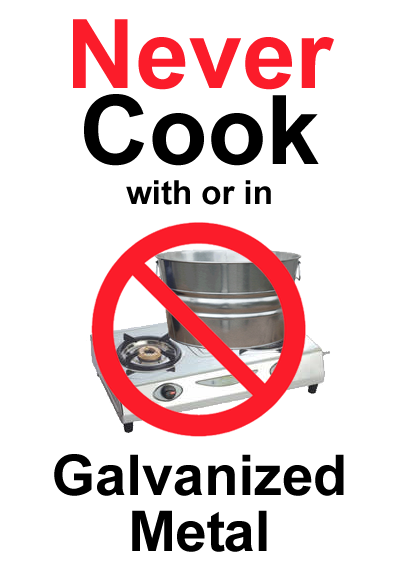Is Galvanized Steel Toxic ?
In their finished form, no, galvanized steel buckets, tubs and other galvanized household products present no toxic risk to adults, children, plants or animals.
When it comes to the toxicity of zinc to humans, however, there's a little more to the story. Zinc is ubiquitous in the environment. Significant amounts of zinc can be released from both natural and human origins. Zinc has been detected in air, surface water, groundwater, and soil. Zinc was detected more often and in larger concentrations near source areas like hazardous waste sites and industrial areas such as lead smelters (12 p.183).
Humans are exposed to zinc through ingestion (eating/drinking), inhaling (breathing air), and dermal contact (skin) (12 p.11).
Background: The zinc coating of galvanized metal protects the underlying steel against rust. Zinc is of critical importance for all biological life on on the planet and controls many functions in our bodies.
The National Academy of Sciences (NAS) estimates Recommended Daily Allowances (RDAs) for zinc of 11 mg/day for men, 8 mg/day for women, 2-3 mg/day for infants, and 5-9 mg/day for children. Extra dietary levels of zinc are recommended for women during pregnancy (11-12 mg/day) and lactation (12-13 mg/day) (12 p.8).
Zinc is found widely in commonly consumed foods. It is higher in foods of animal origin, and particularly in seafood. Meat products are comprised with comparably high concentrations of zinc, than fruits and vegetables which consist of relatively low zinc concentrations (12 p.11).
For centuries, people in rural areas have collected rainwater for drinking from galvanized roofing. Corrosion-resistant galvanized troughs and tubs have watered livestock and pets since they were invented. Water in urban areas was supplied in galvanized pipes for many years. There is evidence to suggest these practices contributed to healthy zinc levels in humans and animals. The problem with galvanized steel for drinking water occurs when the galvanized steel gets old. After 50 years of water and environmental exposure the zinc coating deteriorates exposing and rusting the underlying seel which is toxic to drink. Galvanized steel for drinking water should be replaced every 50 years or so. Read how long does galvanized steel last.
Small amounts of zinc are considered an essential micronutrient for both plants and humans. Yes zinc is key to life on earth, but too much zinc can lead to zinc toxicity. Individuals involved in galvanizing, smelting, welding, or brass foundry operations are exposed to unfinished metallic zinc and zinc compounds. These compounds are dangerous and present only during the manufacturing process (12 p.11). Zinc toxicity can occur when an individual is exposed to and breathes the heated yellowish fumes produced from welding or heating galvanized steel. For hot-dipped galvanized steel the recommended maximum temperature is 392 F (200 C), before the metal presents a toxicity risk.
EPA has states drinking water should contain no more than 5 mg of zinc per liter of water (5 mg/L or 5 ppm) because of taste. Furthermore, any release of more than 1,000 pounds (or in some cases 5,000 pounds) of zinc or its compounds into the environment (i.e., water, soil, or air) must be reported to EPA.
Although industry and environmental factors determine body exposure to zinc, the zinc found in home products such as paint, ointments, galvanized metals, coins, and dietary supplements, are low and do not disproportionately affect children or other vulnerable populations, according to a 2003 report by the Agency for Toxic Substances (12).
An unverified risk for preventing zinc toxicity from galvanized steel exposure is keeping galvanized metal surfaces away from direct contact with acidic foods. Galvanized metal containers are not safe to serve food and drinks in, According to the USDA. The acidity of the food or drink could dissolve the zinc coating allowing it to leach into the food or drink. Solutions that have a PH of higher than 12 (lye, bleach) and lower than 6 (vinegar, soda, lemon juice) should always be avoided in a galvanized container.
Jump to: Is Galvanized Metal Safe for Food? Is it safe to cook with galvanized steel?
What about using galvanized steel for planters? It is considered safe to use galvanized metal containers for planting. If plants in your galvanized container absorb the zinc, it is will be in small amounts. The plants themselves will show toxicity if the amounts are too large.
If you think your plants are receiving too much zinc, try using a plastic liner inside the galvanized container to minimize soil contact; especially in older galvanized containers. Old galvanized containers already rusting present a greater metal toxicity risk than newer galvanized containers. More on the safety of growing food in galvanized containers.
Is Galvanized Metal Safe for Food?
Our galvanized steel buckets and tubs are popular for keeping drinks in their containers cold. However, galvanized steel does not meet USDA food safe serving standards for acidic foods; like tomatoes, pickles, fish and fruit juices. Galvanized metal is not safe for cooking or storing food. Foods with low acidity do not react with the galvanized steel and, according to the USDA, are safe to serve on galvanized steel.
We recommend when serving food from galvanized containers, line your galvanized tray, bucket, or tub with wax paper, parchment paper or plastic wrap. This way you do not have to worry about properly identifying your food as a high-acid or low-acid food.
The acid in some foods will react with the zinc coating to form salts. An excesses consumption of these salts could cause a mild sickness. Although these salts are readily absorbed by the body, we recommend getting your daily dose of zinc directly from the foods you eat: try pumpkin seeds, garlic, dark chocolate, sesame seeds, or chickpeas.
The photo below is a picture we took at a summer festival of sourdough bread in a galvanized bucket, there were no reports of zinc poisoning.

Zinc toxicity symptoms begin 3 to 12 hours after ingestion and include: diarrhea, vomiting, fever. Milk should be given immediately to an individual with zinc toxicity and professional medical help should be sought. Milk helps neutralize the digestive tract with too much zinc.
If your heart is set serving food from a metal bucket, try our food-safe easy to clean 13 quart stainless steel water bucket is rust and scratch proof, odor-free, hygienic and dishwasher safe.
Is It Safe To Cook With Galvanized Metal
Cooking vessels, untientials and food storage containers are generally not made out of galvanized steel. There are, however, the infrequent accounts of galvanized containers like trash cans and tubs being used for big cookouts or parties. People do it. But is it safe?
Zinc fumes are set free when galvanised steel is heated. These fumes are very toxic to breathe. Deposits of zinc from the fumes accumulate in the food. Utensils like ladles and galvanized-surfaced pails should not be used for food cooking. There are no USDA certified-safe galvanized metal cooking surfaces or containers.

Galvanized fumes are released when the galvanized metal reaches a certain temperature. This temperature varies by the galvanization process used. In long-term, continuous exposure, the recommended maximum temperature for hot-dip galvanized steel is 392 F (200 C), according to the American Galvanizers Association.



